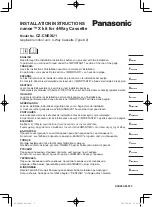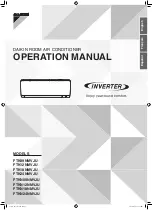
3
WARNING
ELECTRICAL SHOCK HAZARD
Before performing service or maintenance operation on
unit, turn off and lock off main power switch to unit. Elec-
trical shock can cause personal injury and death. Shut off
all power to this equipment during installation and service.
The unit may have an internal non-fused disconnect or a
field-installed disconnect.
CAUTION
UNIT DAMAGE HAZARD
This unit uses a microprocessor-based electronic control
system.
Do not
use jumpers or other tools to short out com-
ponents or to bypass or otherwise depart from recommend-
ed procedures. Any short-to-ground of the control board or
accompanying wiring may destroy the electronic modules
or electrical components.
WARNING
If the information in this manual is not followed exactly, a
fire or explosion may result causing property damage, per-
sonal injury or loss of life.
Do not store or use gasoline or other flammable vapors and
liquids in the vicinity of this or any other appliance.
WHAT TO DO IF YOU SMELL GAS
• Do not try to light any appliance.
• Do not touch any electrical switch; do not use any
phone in your building.
• Immediately call your gas supplier from a neighbor’s
phone. Follow the gas supplier’s instructions.
• If you cannot reach your gas supplier, call the fire
department.
Installation and service must be performed by a qualified
installer, service agency or the gas supplier.
AVERTISSEMENT
RISQUE D´INCENDIE OU D´EXPLOSION
Si les consignes de sécurité ne sont pas suivies à la lettre,
cela peut entraîner la mort, de graves blessures ou des dom-
mages matériels.
Ne pas entreposer ni utiliser d´essence ni autres vapeurs ou
liquides inflammables à proximité de cet appareil ou de tout
autre appareil.
QUE FAIRE SI UNE ODEUR DE GAZ EST DÉTECTÉE
• Ne mettre en marche aucun appareil.
• Ne toucher aucun interrupteur électrique; ne pas
utiliser de téléphone dans le bâtiment.
• Quitter le bâtiment immédiatement.
• Appeler immédiatement le fournisseur de gaz en
utilisant le téléphone d´un voisin. Suivre les
instructions du fournisseur de gaz.
• Si le fournisseur de gaz n´est pas accessible, appeler le
service d´incendie.
L´installation et l´entretien doivent être effectués par un in-
stallateur ou une entreprise d´entretien qualifié, ou le four-
nisseur de gaz.
WARNING
DO NOT USE TORCH to remove any component. System
contains oil and refrigerant under pressure.
To remove a component, wear protective gloves and gog-
gles and proceed as follows:
a. Shut off electrical power to unit.
b. Recover refrigerant to relieve all pressure from system
using both high-pressure and low pressure ports.
c. Traces of vapor should be displaced with nitrogen and
the work area should be well ventilated. Refrigerant in
contact with an open flame produces toxic gases.
d. Cut component connection tubing with tubing cutter and
remove component from unit. Use a pan to catch any oil
that may come out of the lines and as a gage for how
much oil to add to the system.
e. Carefully un-sweat remaining tubing stubs when neces-
sary. Oil can ignite when exposed to torch flame.
Failure to follow these procedures may result in personal
injury or death.
WARNING
CARBON-MONOXIDE POISONING HAZARD
Failure to follow instructions could result in severe personal
injury or death due to carbon-monoxide poisoning, if com-
bustion products infiltrate into the building.
Check that all openings in the outside wall around the vent
(and air intake) pipe(s) are sealed to prevent infiltration of
combustion products into the building.
Check that furnace vent (and air intake) terminal(s) are not
obstructed in any way during all seasons.
AVERTISSEMENT
RISQUE D’INTOXICATION AU MONOXYDE DE
CARBONE
Si ces directives ne sont pas suivies, cela peut entraîner des
blessures graves ou une intoxication au monoxyde de car-
bone pouvant causer la mort, si des produits de combustion
s’infiltrent dans le bâtiment.
Vérifier que toutes les ouvertures pratiquées dans le mur
extérieur autour du ou des tuyaux d’évent (et de la prise
d’air) sont scellées de manière à empêcher l’infiltration de
produits de combustion dans le bâtiment.
Veiller à ce que la ou les sorties de l’évent de l’appareil de
chauffage (et la prise d’air) ne soient, en aucune façon, ob-
struées, quelle que soit la saison.
CAUTION
DO NOT re-use compressor oil or any oil that has been ex-
posed to the atmosphere. Dispose of oil per local codes and
regulations. DO NOT leave refrigerant system open to air
any longer than the actual time required to service the
equipment. Seal circuits being serviced and charge with dry
nitrogen to prevent oil contamination when timely repairs
cannot be completed. Failure to follow these procedures
may result in damage to equipment.
Summary of Contents for Weathermaster 48P2030-100
Page 130: ...130 Fig 19 Typical Power Schematic Sizes 040 075 Shown ...
Page 131: ...131 Fig 20 Main Base Board Input Output Connections ...
Page 132: ...132 Fig 21 RXB EXB CEM SCB Input Output Connections ...
Page 133: ...133 Fig 22 Typical Gas Heat Unit Control Wiring 48P030 100 Units Shown ...
Page 134: ...134 Fig 23 Typical Electric Heat Wiring 50P030 100 Units Shown ...
Page 135: ...135 Fig 24 Typical Power Wiring 115 V ...
Page 136: ...136 Fig 25 Typical Gas Heat Section Size 030 050 Units Shown ...
Page 138: ...138 Fig 27 Component Arrangement Size 030 035 Units ...
Page 139: ...139 Fig 28 Component Arrangement Size 040 075 Units ...
Page 140: ...140 Fig 29 Component Arrangement Size 090 100 Units ...




































